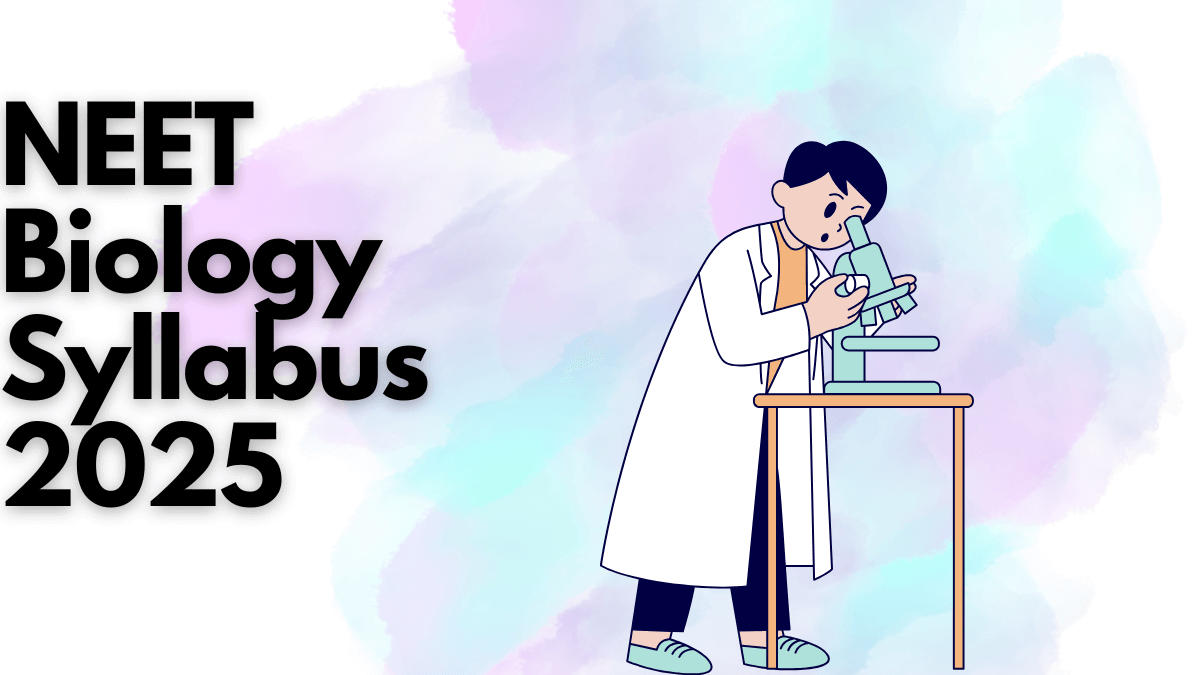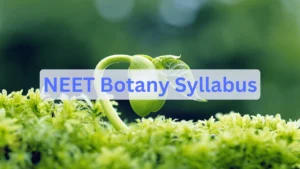Table of Contents
NEET Biology Syllabus 2025: Students can download a thorough NEET 2025 Biology syllabus PDF that comprises all topics from grades 11 and 12 that are covered in the medical entrance test from this article. Understanding the NEET Syllabus for Biology with chapter-by-chapter weightage enables students to concentrate on key areas. Aspirants preparing for NEET 2025 should follow the approved Biology syllabus for their study. The NEET UG 2025 examination date is fixed for May 4, 2025. So, gear up your preparation and complete the unfinished chapters.
NEET Biology Syllabus 2025
Biology accounts for half the questions and marks in the NEET UG exam, making this section highly crucial for success. Students must understand every concept from this subject to increase their total marks. Students can effectively prepare all the topics by going through the official NEET Biology syllabus shared here. Completing the syllabus requires disciplined learning and perseverance with the right approach. As per the revised exam pattern, the NEET UG 2025 biology section will have 90 compulsory questions for 360 marks.
NEET 2025 Biology Syllabus Overview
The biology section has a significant impact on applicants’ overall NEET exam performance. Mastering NEET 2025 requires a complete understanding of the Biology syllabus, with a concentration on all of the major topics covered. Have a clear idea of the NEET Biology syllabus in this article.
Latest NEET UG Biology Syllabus 2025
Check the complete NEET Biology syllabus 2025 below.
Revised NEET Biology Syllabus 2025
UNIT 1: Diversity in Living World
What is living? ; Biodiversity; Need for classification;; Taxonomy & Systematics; Concept of species and taxonomical hierarchy; Binomial nomenclature; Five kingdom classification; salient features and classification of Monera; Protista and Fungi into major groups; Lichens; Viruses and Viroids. Salient features and classification of plants into major groups-Algae, Bryophytes, Pteridophytes, Gymnosperms (three to five salient and distinguishing features and at least two examples of each category); Salient features and classification of animals, non-chordate up to phyla level and chordate up to class level (three to five salient features and at least two examples).
UNIT 2: Structural Organisation in Animals and Plants
Morphology and Modifications : Tissues; Anatomy and functions of different parts of flowering plants: Root, stem, leaf, inflorescence- cymose and recemose, flower, fruit and seed (To be dealt along with the relevant practical of the Practical Syllabus) Family (malvaceae, Cruciferae, leguminoceae, compositae, graminae). Animal Tissues: Morphology, anatomy and functions of different systems (digestive, circulatory, respiratory, nervous and reproductive) of an insect (Frog). (Brief account only)
UNIT 3: Cell Structure and Function
Cell Theory and Cell as the Basic Unit of Life: Structure of prokaryotic and eukaryotic cell; Plant cell and animal cell; Cell envelope, cell membrane, cell wall; Cell organellesstructure and function; Endomembrane system-endoplasmic reticulum, Golgi bodies, lysosomes, vacuoles; mitochondria, ribosomes, plastids, micro bodies; Cytoskeleton, cilia, flagella, centrioles (ultra structure and function); Nucleus-nuclear membrane, chromatin, nucleolus. Chemical Constituents of Living Cells : Biomolecules-structure and function of proteins, carbohydrates, lipids, nucleic acids; Enzymes-types, properties, enzyme action, classification and nomenclature of enzymes. B Cell Division : Cell cycle, mitosis, meiosis and their significance.
UNIT 4: Plant Physiology
Photosynthesis : Photosynthesis as a means of Autotrophic nutrition; Site of photosynthesis takes place; pigments involved in Photosynthesis (Elementary idea); Photochemical and biosynthetic phases of photosynthesis; Cyclic and non cyclic and photophosphorylation; Chemiosmotic hypothesis; Photorespiration C3 and C4 pathways; Factors affecting photosynthesis. Respiration : Exchange gases; Cellular respiration-glycolysis, fermentation (anaerobic), TCA cycle and electron transport system (aerobic); Energy relations- Number of ATP molecules generated; Amphibolic pathways; Respiratory quotient. Plant Growth and Development: Seed germination; Phases of Plant Growth and plant growth rate; Conditions of Growth; Differentiation, Dedifferentiation and redifferentiation; Sequence of developmental process in a plant cell; Growth regulators: auxin, gibberellin, cytokinin, ethylene, ABA;
UNIT 5: Human Physiology
Breathing and Respiration : Respiratory organs in animals (recall only); Respiratory system in humans; Mechanism of breathing and its regulation in humans-Exchange of gases, transport of gases and regulation of respiration Respiratory volumes; Disorders related to respiration-Asthma, Emphysema, Occupational respiratory disorders. Body Fluids and Circulation : Composition of blood, blood groups, coagulation of blood; Composition of lymph and its function; Human circulatory system-Structure of human heart and blood vessels; Cardiac cycle, cardiac output, ECG, Double circulation; Regulation of cardiac activity; Disorders of circulatory system-Hypertension, Coronary artery disease, Angina pectoris, Heart failure. Excretory Products and Their Elimination : Modes of excretion- Ammonotelism, ureotelism, uricotelism; Human excretory system-structure and fuction; Urine formation, Osmoregulation; Regulation of kidney function-Renin-angiotensin, Atrial Natriuretic Factor, ADH and Diabetes insipidus; Role of other organs in excretion; Disorders; Uraemia, Renal failure, Renal calculi, Nephritis; Dialysis and artificial kidney. Locomotion and Movement : Types of movement- ciliary, fiagellar, muscular; Skeletal muscle- contractile proteins and muscle contraction; Skeletal system and its functions (To be dealt with the relevant practical of Practical syllabus); Joints; Disorders of muscular and skeletal system-Myasthenia gravis, Tetany, Muscular dystrophy, Arthritis, Osteoporosis, Gout. Neural Control and Coordination : Neuron and nerves; Nervous system in humanscentral nervous system, peripheral nervous system and visceral nervous system; Generation and conduction of nerve impulse; Chemical Coordination and Regulation : Endocrine glands and hormones; Human endocrine system-Hypothalamus, Pituitary, Pineal, Thyroid, Parathyroid, Adrenal, Pancreas, Gonads; Mechanism of hormone action (Elementary Idea); Role of hormones as messengers and regulators, Hypo-and hyperactivity and related disorders (Common disorders e.g. Dwarfism, Acromegaly, Cretinism, goiter, exopthalmic goiter, diabetes, Addison’s disease). (Imp: Diseases and disorders mentioned above to be dealt in brief)
UNIT 6: Reproduction
Sexual Reproduction in Flowering Plants : Flower structure; Development of male and female gametophytes; Pollination-types, agencies and examples; Outbreeding devices; Pollen-Pistil interaction; Double fertilization; Post fertilization events- Development of endosperm and embryo, Development of seed and formation of fruit; Special modesapomixis, parthenocarpy, polyembryony; Significance of seed and fruit formation. Human Reproduction : Male and female reproductive systems; Microscopic anatomy of testis and ovary; Gametogenesis-spermatogenesis & oogenesis; Menstrual cycle; Fertilisation, embryo development upto blastocyst formation, implantation; Pregnancy and placenta formation (Elementary idea); Parturition (Elementary idea); Lactation (Elementary idea). Reproductive Health : Need for reproductive health and prevention of sexually transmitted diseases (STD); Birth control-Need and Methods, Contraception and Medical Termination of Pregnancy (MTP); Amniocentesis; Infertility and assisted reproductive technologies – IVF, ZIFT, GIFT (Elementary idea for general awareness).
UNIT 7: Genetics and Evolution
Heredity and Variation : Mendelian Inheritance; Deviations from MendelismIncomplete dominance, Co-dominance, Multiple alleles and Inheritance of blood groups, Pleiotropy; Elementary idea of polygenic inheritance; Chromosome theory of inheritance; Chromosomes and genes; Sex determination-In humans, birds, honey bee; Linkage and crossing over; Sex-linked inheritance-Haemophilia, Colour blindness; Mendelian disorders in humans-Thalassemia; Chromosomal disorders in humans; Down’s syndrome, Turner’s and Klinefelter’s syndromes. Molecular Basis of Inheritance : Search for genetic material and DNA as genetic material; Structure of DNA and RNA; DNA packaging; DNA replication; Central dogma; Transcription, genetic code, translation; Gene expression and regulation- Lac Operon; Genome and human genome project; DNA finger printing, protein biosynthesis. Evolution : Origin of life; Biological evolution and evidence for biological evolution from Paleontology, comparative anatomy, embryology and molecular evidence); Darwin’s contribution, Modern Synthetic theory of Evolution; Mechanism of evolution Variation (Mutation and Recombination) and Natural Selection with examples, types of natural selection; Gene flow and genetic drift; Hardy-Weinberg’s principle; Adaptive Radiation; Human evolution.
UNIT 8: Biology and Human Welfare
Health and Disease : Pathogens; parasites causing human diseases (Malaria, Filariasis, Ascariasis. Typhoid, Pneumonia, common cold, amoebiasis, ring worm, dengue, chikungunya); Basic concepts of immunology-vaccines; Cancer, HIV and AIDS; Adolescence, drug and alcohol abuse.Tobacco abuse. Microbes in Human Welfare : In household food processing, industrial production, sewage treatment, energy generation and as biocontrol agents and biofertilisers.
UNIT 9: Biotechnology and Its Applications
Principles and Process of Biotechnology : Genetic engineering (Recombinant DNA technology). Application of Biotechnology in Health and Agriculture : Human insulin and vaccine production, gene therapy; Genetically modified organisms-Bt crops; Transgenic Animals; Biosafety issues-Biopiracy and patents.
UNIT 10: Ecology and Environment
Organisms and Environment: Population interactions-mutualism, competition, predation, parasitism; Population attributes-growth, birth rate and death rate, age distribution. Ecosystem : Patterns, components; productivity and decomposition; Energy flow; Pyramids of number, biomass, energy. Biodiversity and Its Conservation : Concept of Biodiversity; Patterns of Biodiversity; Importance of Biodiversity; Loss of Biodiversity; Biodiversity conservation; Hotspots, endangered organisms, extinction, Red Data Book, biosphere reserves, National parks and sanctuaries, Sacred Groves .
NEET Biology Class 11 Syllabus 2025
The NEET syllabus 2025 for biology for Class 11 is very important in preparing. Here is an overview of the NEET syllabus 2025 for biology for Class 11.
NEET Biology Class 12 Syllabus 2025
It covers a variety of topics including human reproduction, evolution, ecology, biotechnology, genetics, and others. The NEET 2025 biology syllabus for Class 12 emphasizes building on the foundational concepts presented in Class 11 while also delving into more complex themes and principles in biology. The redesigned NEET 2025 biology syllabus contains the main themes and subtopics.
NTA NEET Biology Syllabus PDF 2025
Students can understand topic additions and removals by downloading the Biology Syllabus PDF and familiarizing themselves with the new NEET 2025 biology syllabus. Understanding the NEET biology syllabus helps students categorize topics according to their value and prepares them for the exam. Download the official pdf from the below link.
Candidates can check the syllabus for other sections of NEET exam below.
| Domain | Syllabus | Previous Year Question |
| Chemistry | NEET Chemistry syllabus | NEET Chemistry Previous Year Question Paper |
| Physics | NEET Physics Syllabus | NEET Physics Previous Year Question Paper |
NEET Biology Syllabus Chapter-wise Weightage
Prior to commencing their preparation, candidates need to understand the chapter-by-chapter importance of Biology for NEET. The table below provides a summary of the scores assigned to each chapter in NEET 2025 Biology.
NEET Zoology Syllabus 2025 with Weightage
The NEET zoology syllabus 2025 with weightage provides a comprehensive framework for assessing students’ skill and understanding of zoology through five major themes. Candidates should become aware with the chapter-by-chapter weighting distribution of marks for the NEET Syllabus 2025 before beginning their preparation. The NEET zoology syllabus 2025 is intended to examine candidates’ understanding of many zoological topics, including animal categorization, structural structure, cell biology, and human physiology.
| Chapters/Topics | Weightage (%) |
Average No. of Questions asked ( Based on 5 Years Analysis)
|
|
Structural Organisation in Animals (Animal Tissues)
|
8% | 4 |
|
Locomotion and Movement
|
6% | 3 |
|
Body Fluids and Circulation
|
5% | 2 |
| Evolution | 6% | 3 |
| Biomolecules | 10% | 5 |
|
Human Reproduction
|
6% | 3 |
|
Breathing and Exchange of Gases
|
4% | 2 |
|
Excretory Products and their Elimination
|
5% | 2 |
|
Reproductive Health
|
8% | 4 |
|
Biotechnology – Principles and Processes
|
12% | 6 |
|
Human Health and Disease
|
6% | 3 |
|
Biotechnology and its Applications
|
7% | 4 |
| Animal Kingdom | 13% | 7 |
|
Neural Control and Coordination
|
2% | 1 |
|
Chemical Coordination and Integration
|
4% | 2 |
NEET Botany Syllabus 2025 with Weightage
The NEET botany syllabus for 2025 covers a wide range of plant-related topics. It is organized into four major sections: biochemistry, cell biology, genetics, and ecology. The following are the key subjects and the marks allotted to each chapter of the NEET 2025 Botany Syllabus, which is necessary for good study planning.
| Chapters/Topics | Weightage (%) |
Average No. of Questions asked ( Based on 5 Years Analysis)
|
|
Biodiversity and Conservation
|
4% | 2 |
|
Anatomy of Flowering Plants
|
7% | 3 |
|
Cell : The Unit of Life
|
5% | 2 |
|
Respiration in Plants
|
4% | 2 |
|
Microbes in Human Welfare
|
4% | 2 |
|
Cell Cycle and Cell Division
|
9% | 4 |
|
Molecular Basis of Inheritance
|
14% | 6 |
|
Principles of Inheritance and Variation
|
10% | 5 |
|
Sexual Reproduction in Flowering Plants
|
6% | 3 |
| Ecosystem | 4% | 2 |
|
Morphology of Flowering Plants
|
6% | 3 |
|
Plant Growth and Development
|
6% | 3 |
| The Living World | 1% | 0 |
| Plant Kingdom | 7% | 3 |
|
Biological Classification
|
3% | 1 |
|
Organisms and Populations
|
4% | 2 |
|
Photosynthesis in Higher Plants
|
4% | 2 |
| All NEET UG Related Articles | |
| NEET 2025 Exam Date | |
| NEET Exam Pattern | |
| NEET Age Limit | |
| NEET Online Coaching | |
| NEET Question paper | |
NEET UG 2025 Biology Important Chapters
It is recommended that applicants focus their studies on specific core biology subjects from the NEET botany curriculum 2025 and NEET Zoology syllabus 2025 for NEET UG 2025, as decided by the frequency and weightage of questions in previous years’ tests. These topics are extremely important because they appear frequently in the biology syllabus for the NEET 2025 exam. If you truly learn and master these concepts, your biological foundation will be strengthened, increasing your chances of success in the NEET exam. Here are the essential subjects to focus on during NEET preparation:
| NEET 2025 Syllabus Important Topics | |||
| Botany | Zoology | ||
| Chapter Name | Topics | Chapter Name | Topics |
|
Cell – The Unit of Life
|
CELL THEORY AN OVERVIEW OF CELL PROKARYOTIC CELLS EUKARYOTIC CELLS |
Chapter Name | Topics |
|
Cell Cycle and Cell Division
|
CELL CYCLE Phases of Cell Cycle Significance of Mitosis MEIOSIS I MEIOSIS MEIOSIS II Significance of Meiosis |
Structural Organization in Animals (including Frog) |
Tissues
Epithelium Tissue Cell Junctions Connective Tissue Muscular Tissue Nervous Tissue Cockroach Frog |
| The Living World | WHAT IS ‘LIVING’? DIVERSITY IN THE LIVING WORLD Binomial nomenclature TAXONOMIC CATEGORIES |
Biomolecules |
Method to analyze chemical composition
Metabolites Micromolecules Macromolecules Carbohydrates Amino acids Proteins Lipids Nucleic acids RNA DNA Dynamic state of body constituents The living state Enzymes |
|
Biological Classification
|
Types of Classification KINGDOM MONERA KINGDOM PROTISTA KINGDOM FUNGI KINGDOM PLANTAE KINGDOM ANIMALIA acellular organisms Symbiotic organisms |
Breathing and Exchange of Gases |
Introduction to breathing and respiration
Respiratory organs Human respiratory system Mechanism of breathing Respiratory volumes and capacities Exchange of gases Transportation of gases Regulation of respiration Disorders of Respiratory System |
| Plant Kingdom | Classification system Taxonomy ALGAE BRYOPHYTES PTERIDOPHYTES GYMNOSPERMS |
Body Fluids and Circulation |
Introduction to body fluids
Blood Plasma Formed elements Blood Groups Coagulation of Blood Lymph Circulatory Pathways Double Circulation Coronary Circulation Human Circulatory System Heart Sounds Blood Vessels Portal system ECG Regulation of Cardiac Activity Disorders of Circulatory System |
|
Morphology of Flowering Plants
|
THE ROOT THE STEM THE LEAF THE FLOWER THE FRUIT THE SEED SEMI-TECHNICAL DESCRIPTION OF A TYPICAL FLOWERING PLANT DESCRIPTION OF SOME IMPORTANT FAMILIES |
Excretory Products & their Elimination |
Excretion
Excretory Products Excretory Structures Human Excretory System Nephron Mechanism of Urine formation Mechanism of Concentration of the Filtrate Micturition Urine Role of Other Organs in Excretion Regulation of Kidney Function – Kidney Regulation of Kidney Function – Hypothalamus Regulation of Kidney Function – Adrenal cortex Regulation of Kidney Function – Adrenal medulla Regulation of Kidney Function – Heart Regulation of GFR Disorders of the Excretory System Treatment for renal failure |
|
Anatomy of Flowering Plants
|
THE TISSUES Simple Tissues Complex Tissues THE TISSUE SYSTEM Anatomy of Plants |
Locomotion & Movement |
Locomotion and movement
Locomotory organs Types of Movement Muscles Types of Muscle Skeletal muscles Structure of contractile proteins Mechanism of Muscle Contraction Mechanism of Muscle Relaxation Red & White Muscles Skeletal system Axial skeleton Appendicular skeleton Joints Disorders related to muscular system |
|
Photosynthesis in Higher Plants
|
EARLY EXPERIMENTS WHERE DOES PHOTOSYNTHESIS TAKE PLACE? HOW MANY TYPES OF PIGMENTS ARE INVOLVED IN PHOTOSYNTHESIS? WHAT IS LIGHT REACTION? Dark Reaction THE C4 PATHWAY PHOTORESPIRATION FACTORS AFFECTING PHOTOSYNTHESIS |
Neural Control & Coordination |
Control and coordination
Neural system Human neural system Neuron Generation and conduction of nerve impulse Transmission of Impulses Synapse Neurotransmitters Central nervous system(CNS) Human Brain Spinal cord |
|
Respiration in Plants
|
RESPIRATION IN PLANTS GLYCOLYSIS FERMENTATION AEROBIC RESPIRATION THE RESPIRATORY BALANCE SHEET AMPHIBOLIC PATHWAY RESPIRATORY QUOTIENT |
Chemical Coordination & Integration |
Neural system and Endocrine system
Endocrine glands Hormones Hypothalamus Pituitary gland/Hypophysis Pineal gland/body Thyroid gland Parathyroid gland Thymus gland Adrenal gland Pancreas Gonads Hormones of Gastrointestinal Tract Hormones of Heart Hormones of Kidney Non-endocrine tissues Hormonal Feedback Hormonal action |
|
Plant Growth and Development
|
GROWTH Growth Rates DIFFERENTIATION, DEDIFFERENTIATION AND REDIFFERENTIATION DEVELOPMENT PLANT GROWTH REGULATORS |
Animal Kingdom |
Taxonomy
Kingdom-Animalia Basis of Classification Phylum- Porifera Phylum- Coelenterata/Cnidaria Phylum- Ctenophora “Phylum- Platyhelminthes Phylum- Aschelminthes/ Nemathelminthes” Phylum-Annelida Phylum-Arthropoda Phylum- Mollusca Phylum- Echinodermata Phylum- Hemichordata Phylum-Chordata Subphyla- Urochordata Subphyla- Cephalochordata Subphyla- Vertebrata Class- Cyclostomata Superclass- Pisces (Class- Chondrichthyes) Superclass- Pisces (Class- Osteichthyes) Superclass- Tetrapoda (Class – Amphibia) Superclass- Tetrapoda (Class – Reptiles) Superclass- Tetrapoda (Class – Aves) Superclass- Tetrapoda (Class – Mammalia) |
|
Sexual Reproduction in Flowering Plant
|
FLOWER – A FASCINATING ORGAN OF ANGIOSPERMS PRE-FERTILISATION: STRUCTURES AND EVENTS Pollen grain Female gametophyte Pollination POST-FERTILISATION: STRUCTURES AND EVENTS Embryo Seed Fruit APOMIXIS AND POLYEMBRYONY |
Human Reproduction |
Human reproductive system
Male reproductive system Female reproductive system Spermatogenesis semen Structure of sperm Oogenesis Differences between spermatogenesis and oogenesis Ovum Menstrual cycle Fertilisation & Implantation Sex Determination of Foetus Pregnancy & embryonic development Parturition & Lactation |
|
Principle of Inheritance and Variation
|
Genetics MENDEL’S LAWS OF INHERITANCE INHERITANCE OF ONE GENE INHERITANCE OF TWO GENES POLYGENIC INHERITANCE PLEIOTROPY SEX DETERMINATION MUTATION GENETIC DISORDERS Mendelian Disorders Chromosomal Disorders |
Reproductive Health |
Reproductive health
Population Contraceptive methods Medical termination of pregnancy Sexually transmitted diseases(STDs) Infertility Assisted reproductive technologies(ARTs) |
|
Molecular Basis of Inheritance
|
THE DNA THE SEARCH FOR GENETIC MATERIAL RNA WORLD THE DNA DNA Replication TRANSCRIPTION GENETIC CODE RNA– the Adapter Molecule TRANSLATION REGULATION OF GENE EXPRESSION HUMAN GENOME PROJECT DNA FINGERPRINTING |
Evolution |
Origin of life
Theory of origin of life Evolution Evidences of evolution Adaptive radiation Natural selection and artificial selection Theory of organic evolution Hardy-weinberg principle Speciation and isolation A brief account on evolution Origin and evolution of man |
|
Microbes in Human Welfare
|
MICROBES IN HUMAN WELFARE MICROBES IN SEWAGE TREATMENT MICROBES IN PRODUCTION OF BIOGAS MICROBES AS BIOCONTROL AGENTS MICROBES AS BIOFERTILISERS |
Human Health and Diseases |
Introduction
Common Diseases in Humans Protozoan Disease Immunity Innate immunity Acquired immunity Lymphoid organs Immunization Vaccination Transplantation Auto-immunity AIDS Cancer Drug abuse Alcohol abuse Adolescence Addiction and dependence |
|
Organisms and Population
|
ORGANISM AND ITS ENVIRONMENT POPULATIONS Population Growth Life History Variation Population Interactions |
Biotechnology: Principles & Processes |
Principles of biotechnology
Genetic engineering/Recombinant DNA technology Tools of rDNA technology Isolation of DNA Separation and isolation of DNA fragments Amplification of gene of interest Insertion of rDNA into host cell Obtaining the foreign gene product GMOs Biotechnological applications in agriculture Biotechnological applications in medicine Transgenic animals Ethical issues |
| Ecosystem |
ECOSYSTEM – STRUCTURE AND FUNCTION
ENERGY FLOW ECOLOGICAL PYRAMIDS |
||
|
Biodiversity and Conservation
|
BIODIVERSITY
Patterns of Biodiversity Loss of Biodiversity BIODIVERSITY CONSERVATION Why Should We Conserve Biodiversity? BIODIVERSITY CONSERVATION |
||
Topics Deleted from NEET Biology Syllabus
Candidates can check the topics removed from the NEET UG Biology syllabus below so that they do not study these topics by mistake.
Required Study Materials for NEET Biology
Our team has prepared this study material for the effective preparation of the students. Check them below –
| Helpful NEET Preparation Tools | |
| NEET Course 2025 | NEET Books |
| NEET Online Coaching 2025 | NEET eBooks |
| NEET Mock Test 2025 | |
NEET Biology Syllabus Preparation Tips
Getting ready for the NEET 2025 Biology syllabus necessitates careful planning and focused study. Here are a few suggestions to assist you in preparing efficiently:
- Grasp the Curriculum: Acquaint yourself with the NEET 2025 Biology curriculum. Familiarize yourself with the themes and subthemes to arrange your study schedule appropriately.
- Conceptual Comprehension: Emphasize developing a solid conceptual comprehension of the Biology NEET Syllabus 2025 instead of mere rote learning. This will assist you in responding to a variety of questions throughout the exam.
- Consistent Practice: Engaging in practice is crucial to grasp the Biology syllabus for NEET 2025. Work through past years’ question papers, sample papers, and practice tests to become accustomed to the exam format and enhance your time management skills.
- Take Notes: Write brief notes as you study every subject. Highlight essential concepts, diagrams, and equations to facilitate fast review as the exam approaches.
- Utilize Trustworthy Resources: Consult NCERT textbooks along with other suggested study materials for Biology NEET 2025 preparation. Web resources, video presentations, and engaging quizzes can additionally enhance your education.
- Concentrate on Weak Points: Recognize your weak points and dedicate additional time to grasp those concepts completely. Request assistance from educators, mentors, or online communities if necessary.




 NEET UG 2025: Is NEET Previous years Que...
NEET UG 2025: Is NEET Previous years Que...
 NEET Botany Syllabus 2025 Out, Check Cha...
NEET Botany Syllabus 2025 Out, Check Cha...
 NEET Cut Off: NEET 2025 Safe Score By Ca...
NEET Cut Off: NEET 2025 Safe Score By Ca...


